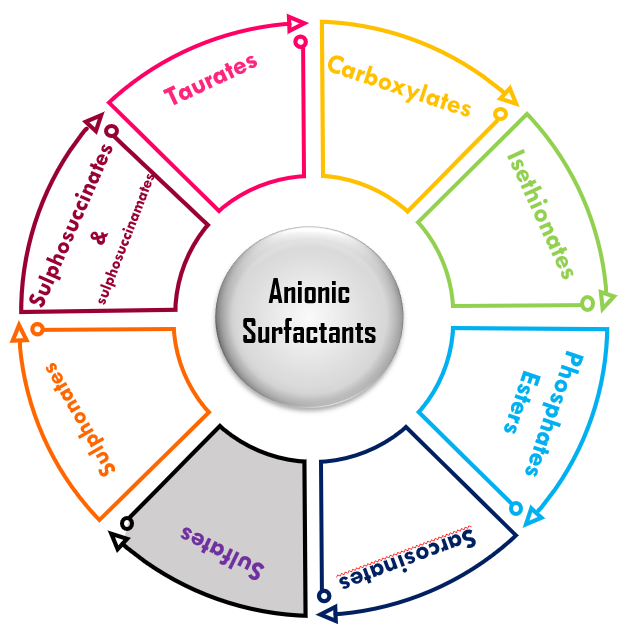The sulfates were the largest and most important class of synthetic surfactants but have now been overtaken by the sulphonates in terms of volume consumption. Organic sulfates are the esters of sulphuric acid.
ROH + H2S04 → ROS03H
The sulfur atom is joined to the carbon atom of the hydrophobic chain via an oxygen atom. The acid ester is unstable and can revert back readily to the alcohol and sulphuric acid (particularly in acid conditions) whereas the neutralized salts are stable at neutral pH. In the case of a sulphonate, the sulfur is joined directly to the carbon chain of the hydrophobe.
In the manufacture of sulfates, the neutralization must be carried out quickly to avoid the breakdown of the acid ester. In practice, sulphuric acid is very seldom used and chlorosulfonic or sulfur trioxide/air mixtures (in continuous reactors) tend to be the most common methods of sulfating alcohols. The neutralization is usually carried out continuously with the sulphation.
Commercial products available with the R group on the alcohol can be:
- A saturated linear hydrocarbon from natural or synthetic (oxo or Ziegler alcohols) sources, CH3(CH2)nOH, with n usually in the range 8-13 and usually linear. The products are then known as the fatty alcohol sulfates.
- Unsaturated alcohols, although sulphation/sulphonation can take place on the unsaturated bond.
- A long-chain alcohol with ethylene oxide, RO(CH2CH2O)nH, with R = C12-C15 and either natural or synthetic but usually linear and with n commonly 2 or 3 but sometimes up to 10. The products are commonly known as ether sulfates.
- An alkylated phenol ethoxylate, RC6H4O (CH2CH2O)nH, with R commonly C9 based on tripropylene (nonyl) and therefore branched with n commonly 4-20. The products are commonly known as nonylphenol ether sulfates.
- A monoethanolamide ethoxylate, RCONHCH2CH2O(CH2CH2O)nH, with R commonly derived from a natural oil (e.g. coconut oil) with n commonly in the range 3-6. The products are known as fatty acid alkanolamide ether sulfates.
The properties of the sulfates depend upon the properties of the hydrocarbon chain and that of the sulfate group. The properties of the hydrocarbon chain are common to those of all other surfactants. It is worth mentioning the secondary alkyl sulfates which were produced by reacting oleum with alpha-olefins from cracked waxes. These products had typical detergent sulfate properties but tended to have disagreeable odors and dark colors. These products are no longer available in Western Europe but they are relatively easy to make with simple equipment and may be available in other parts of the world.
Properties of the sulfate group:
Solubility
The alkali metal salts show good solubility in water.
Physical properties of aqueous solutions
Most surfactant sulfates show what is known as the salt effect. The addition of inorganic salts (sodium chloride, sodium sulfate) to dilute solutions (below about 30%) increases the viscosity, whilst addition to concentrated solutions decreases the viscosity. Any salts formed during the sulphation and/or neutralization can lead to viscosity changes. Sources of salts are moisture during sulphation, hydrolysis of the acid prior to and during neutralization and the addition of hypochlorite bleach.
Chemical stability
Sulfates are easily hydrolyzed particularly by acids (below pH 3.5). The acid hydrolysis releases sulphuric acid which catalyzes the hydrolysis.
The alcohol sulfates are therefore more stable in alkali than acid. The stability depends upon a number of factors but for aqueous formulations to give long-term shelf stability at room temperature, pH range 5-9.5 is preferred. At elevated temperatures (> 50°C) sulfates are unstable. The ammonia salts on the alkaline side (> pH 7) give off ammonia which can be irritating in household products or give odors in industrial products. The ammonium salts are also slightly superior to the sodium or triethanolamine salts with regard to resistance to acid hydrolysis.
Impurities
Hypochlorite bleach is very often added by the surfactant manufacturer to produce better colored material. Residues can often be detected.
This type of anionic surfactants include:
- Alcohol sulfates
- Alcohol ether sulfates
- Sulfated alkanolamide ethoxylates
- Sulfated oils and glycerides
- Nonylphenol ether sulfates

